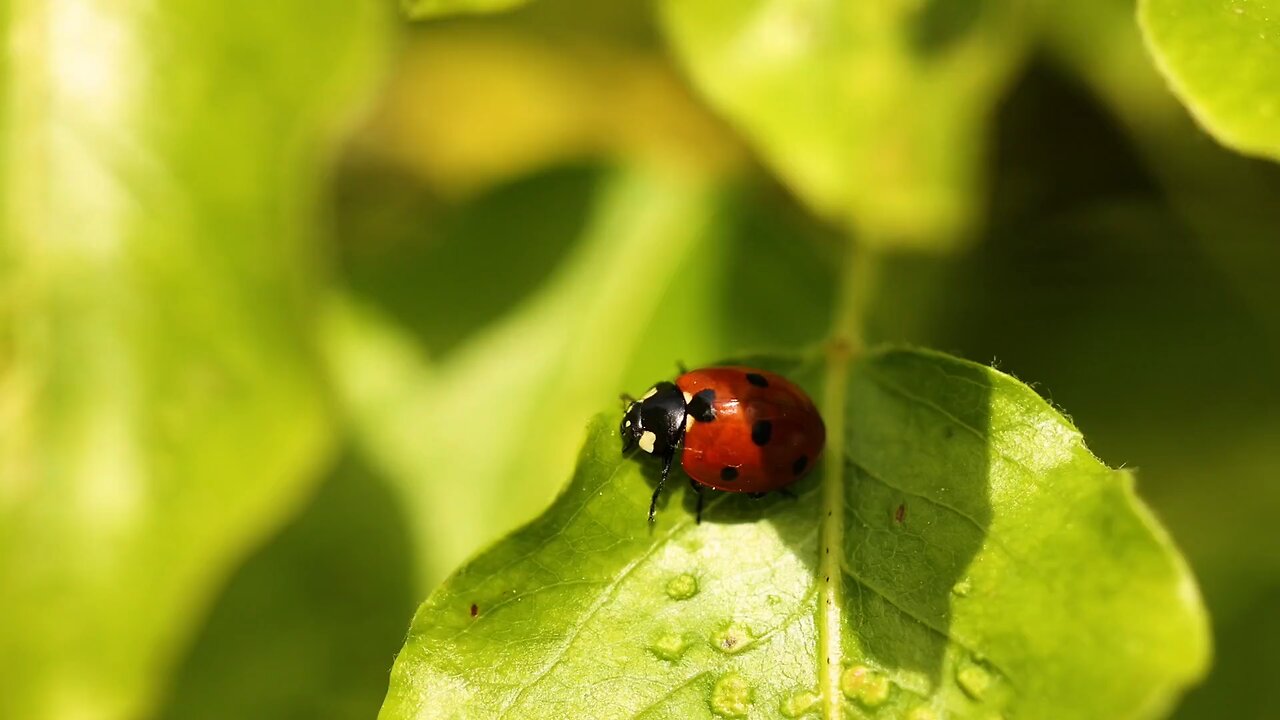Premium Only Content

"Ladybugs: Nature's Tiny Pest Warriors"
Ladybugs, also known as ladybirds or lady beetles, are small, brightly colored beetles belonging to the family Coccinellidae. These insects are widely recognized for their round, dome-shaped bodies and vibrant colors, which typically range from red to orange, with black spots. Ladybugs are found in many parts of the world and are particularly beloved for their role in agriculture as natural pest controllers.
### **Physical Characteristics:**
- **Size and Shape**: Ladybugs are generally small, ranging from 1 to 10 millimeters in length. They have a distinct round or oval shape with a domed back and flat underside.
- **Coloration**: The most common ladybug species are red or orange with black spots, but they can also be yellow, black, white, or even pink. The number of spots varies depending on the species, with some having none at all.
- **Head and Antennae**: Ladybugs have small heads with short antennae, which they use for sensing their environment. Their eyes are typically black and set on the sides of their heads.
### **Life Cycle:**
Ladybugs undergo complete metamorphosis, passing through four distinct stages: egg, larva, pupa, and adult.
- **Egg**: Female ladybugs lay clusters of yellow or orange eggs, usually on the underside of leaves, near aphid colonies (their primary food source). The eggs hatch within a few days.
- **Larva**: The larval stage lasts for about two to four weeks. Ladybug larvae look very different from adults; they are elongated, with a dark, alligator-like appearance and often have colorful markings. During this stage, they consume large numbers of aphids and other soft-bodied pests.
- **Pupa**: After the larval stage, the ladybug enters the pupal stage, attaching itself to a leaf or stem. Inside the pupa, the ladybug undergoes transformation and emerges as an adult after several days.
- **Adult**: Adult ladybugs are fully formed and capable of reproduction. They are also voracious eaters of pests, continuing to consume aphids, mites, and other small insects.
### **Behavior and Diet:**
- **Diet**: Ladybugs are primarily carnivorous, feeding on a variety of soft-bodied insects, particularly aphids, which are harmful to plants. A single ladybug can eat hundreds of aphids in its lifetime, making them highly beneficial to farmers and gardeners.
- **Defense Mechanisms**: Ladybugs have several defense mechanisms. Their bright colors serve as a warning to predators that they might be toxic or distasteful. When threatened, they can secrete a foul-smelling yellow fluid from their leg joints, which deters predators.
- **Migration**: Some ladybug species are known to migrate, particularly in temperate regions where they seek out warm, sheltered spots to hibernate during the winter.
### **Habitat and Distribution:**
Ladybugs are found in a wide range of habitats, including forests, grasslands, gardens, and agricultural fields. They are most commonly seen in areas where their prey, such as aphids, is abundant.
### **Cultural Significance:**
Ladybugs are often considered symbols of good luck and are popular in various cultures. In many traditions, it is believed that seeing a ladybug brings good fortune or that making a wish upon a ladybug will make it come true.
### **Conservation Status:**
Most ladybug species are not endangered and are quite common. However, some species are experiencing declines due to habitat loss, pesticide use, and competition from non-native ladybug species. Conservation efforts focus on preserving natural habitats and reducing the use of harmful pesticides in agriculture.
### **Interesting Facts:**
- **Color Changes**: As ladybugs age, their colors can change, often fading over time.
- **Lifespan**: A ladybug can live for about one to two years, depending on environmental conditions.
- **Variety**: There are over 5,000 species of ladybugs worldwide, with about 500 species found in North America alone.
Ladybugs are not only visually appealing but also play a crucial role in maintaining the health of ecosystems by controlling pest populations. Their presence in gardens and farms is a sign of a balanced and thriving environment.
-
 LIVE
LIVE
Dr Disrespect
5 hours ago🔴LIVE - DR DISRESPECT - WARZONE - STACHE OPS RANKED
2,657 watching -
 LIVE
LIVE
Akademiks
5 hours agoDay 1/30. Diddy Trial Day 14. YSL Steele Presses Diddy Former Asisstant 'MIA' about her Abuse Claims
1,753 watching -
 LIVE
LIVE
The Officer Tatum
1 hour agoLIVE Boulder Attack, Officer LOSES LIFE In Baldwin Shooting, TRNS WINS State Title + MORE EP 115
859 watching -
 LIVE
LIVE
The HotSeat
1 hour agoAmerica Is NOT Bending the Knee to Pride Month + Did Colorado Enable a Terrorist?
683 watching -
 2:18:15
2:18:15
The Quartering
4 hours agoTrump Can't Read? Terror In Colorado, Tomi Lahren Bashes Men, Tinder Bans Short Men?
134K25 -
 1:43:07
1:43:07
Tucker Carlson
3 hours agoBishop Barron on the New Pope, the Foolishness of Atheism, and Why Young Men Are Turning to Christ
121K54 -
 1:09:15
1:09:15
Jeff Ahern
2 hours ago $0.63 earnedMonday Madness With Jeff Ahern
17.3K3 -
 58:34
58:34
Athlete & Artist Show
4 hours agoLIVE Kakegurui PARTY
12.7K -
 2:42:43
2:42:43
The Pascal Show
3 hours agoDIDDY TRIAL LIVE! Former Personal Assistant Capricorn Clark Takes The Stand & More! Day 10
7.96K3 -
 LIVE
LIVE
sophiesnazz
1 hour ago $0.53 earnedSEASON 4 UPDATE l !socials
47 watching